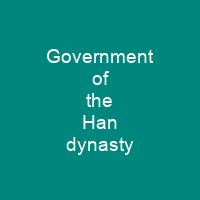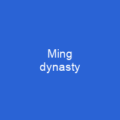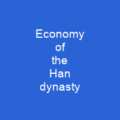The emperor headed the government, promulgating all written laws, serving as commander-in-chief of the armed forces, and presiding as the chief executive official. He appointed all government officials who earned a salary of 600 bushels of grain or more with the help of advisors who reviewed each nominee. The empress dowager could either be the emperor’s actual or symbolic mother, and was in practice more powerful than the emperor, as she could override his decisions.
About Government of the Han dynasty in brief
 The Han dynasty of ancient China was the second imperial dynasty of China, following the Qin dynasty. The emperor headed the government, promulgating all written laws, serving as commander-in-chief of the armed forces, and presiding as the chief executive official. He appointed all government officials who earned a salary of 600 bushels of grain or more with the help of advisors who reviewed each nominee. The empress dowager could either be the emperor’s actual or symbolic mother, and was in practice more powerful than the emperor, as she could override his decisions. During the Han dynasty, the power a government official exercised was determined by his annual salary-rank, measured in grain units known as dan ). However, approximately half an official’s salary in grain was made in payments of cash coins, the standard of which, after 119 BC, was the wushu coin measuring 3. 2 g. The other half of an official’s salary consisted of unhusked grain and husked grain measured in hu ; since one hu of unhuked grain was equal to 100 coins and onehu of huskedgrain was equalto 160 coins, the conversion ratio for unhusker grain to husker grain was 10 to 6. The most senior officials in central government earned a 10,000-dan salary. Local government divisions, in descending order by size, were the province, commandery, county, and district. Local fiefs of the nobility included the kingdom, as well as the marquessate, modelled largely upon the regular county. The conscription system for commoners as non-professional soldiers was reduced in size in favor of a volunteer army and a substitution tax by Eastern Han.
The Han dynasty of ancient China was the second imperial dynasty of China, following the Qin dynasty. The emperor headed the government, promulgating all written laws, serving as commander-in-chief of the armed forces, and presiding as the chief executive official. He appointed all government officials who earned a salary of 600 bushels of grain or more with the help of advisors who reviewed each nominee. The empress dowager could either be the emperor’s actual or symbolic mother, and was in practice more powerful than the emperor, as she could override his decisions. During the Han dynasty, the power a government official exercised was determined by his annual salary-rank, measured in grain units known as dan ). However, approximately half an official’s salary in grain was made in payments of cash coins, the standard of which, after 119 BC, was the wushu coin measuring 3. 2 g. The other half of an official’s salary consisted of unhusked grain and husked grain measured in hu ; since one hu of unhuked grain was equal to 100 coins and onehu of huskedgrain was equalto 160 coins, the conversion ratio for unhusker grain to husker grain was 10 to 6. The most senior officials in central government earned a 10,000-dan salary. Local government divisions, in descending order by size, were the province, commandery, county, and district. Local fiefs of the nobility included the kingdom, as well as the marquessate, modelled largely upon the regular county. The conscription system for commoners as non-professional soldiers was reduced in size in favor of a volunteer army and a substitution tax by Eastern Han.
During times of crisis, the volunteer army increased in size, but large militias were raised and certain officer titles were revived for temporary use. The imperial system fell apart after the fall of Qin in 206 BC. However, following Han’s victory over the Chu King of Chu, the imperial system reestablished and is posthumously known as Emperor Gaozu. The Han system borrowed many core features of its core features from the Qin regime established by Qin Shi Huang in 221 BC. For example, the Qin’s Chancellor Xiao He integrated much of the statutes of the Qin law into the newly-established Han law. For a time, the rulers of the warring states claimed nominal allegiance to an emperor, yet the political prestige of later Chinese emperors was less than that of that of the Zhou kings’ kings. The end of the dynasty came about during a time of civil, military and religious upheaval, which resulted in the period of Three Kingdoms. The government successfully nationalized the issuing of coin currency through its imperial mint, which lasted from 113 BC until the end of Han dynasty. A small professional standing army existed throughout Western and Eastern Han, during times of Crisis, but Large militias were raising and certain Officer titles were raised. During the Warring States period, the government’s monopolies on salt, iron, and liquor eventually failed and were relinquished back to private production.
You want to know more about Government of the Han dynasty?
This page is based on the article Government of the Han dynasty published in Wikipedia (as of Nov. 04, 2020) and was automatically summarized using artificial intelligence.







